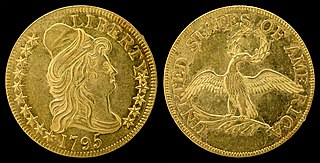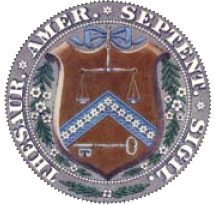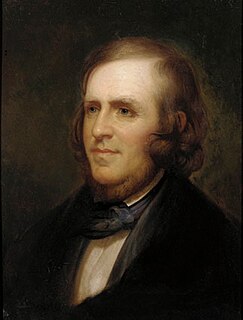
The Charlotte Mint was the first United States branch mint. It was located in Charlotte, North Carolina and specialized in gold coinage.

The Charlotte Mint was the first United States branch mint. It was located in Charlotte, North Carolina and specialized in gold coinage.
Following the first documented discovery of gold in the United States, the country's first gold mine was established in North Carolina at the Reed Gold Mine. As no mints existed in the Charlotte area, miners had to send their gold dust to Philadelphia to be melted and coined. The transportation process was difficult, slow, expensive, and dangerous; frustration with this system led to the creation of private gold coining operations in the Charlotte area. However, making gold into local money had its own inherent problems, such as accurate weighing and determining fineness. In the spring of 1831, North Carolina merchants and miners petitioned Congress for a branch mint in the Charlotte region to reduce the risk of transporting gold. They received no response until three years later when the United States Treasury began to investigate private coining operations and recognized North Carolina's need for more federal coinage. [1]
On March 3, 1835, the United States Congress approved an Act 115 to 60 to establish several branch mints; [1] the act stated, "...one branch [to be established] at the town of Charlotte, in Mecklenburg County, in the state of North Carolina, for the coinage of gold only...And for the purpose of purchasing sites, erecting suitable buildings, and completing the necessary combinations of machinery...for the branch at Charlotte, fifty thousand dollars". [2] This Act also authorized mints at Dahlonega, Georgia, and New Orleans, Louisiana, after President Andrew Jackson signed it into law.


In November, 1835, Levi Woodbury, Secretary of the Treasury, was notified by Samuel MeComb that he had purchased from William Carson and F. L. Smith a full square containing 4 acres of land for $1,500.00, which is now the 400 block of West Trade Street. Proposals for erection of the building were advertised and the contract was awarded to Perry & Ligon, of Raleigh, NC on October 15, 1835 at a price of $29,800.00. In 1836, construction on the Charlotte Mint began. It opened for business on July 27, 1837. Only raw gold was processed and refined until March 28, 1838, when the first $5 gold half eagle was struck in Charlotte. Later that year, $2½ quarter eagles were minted, and 1849 production started on a small gold dollar. All gold coinage coming from this mint has a "C" mint mark to distinguish it from other sister mints then in operation. The Charlotte Mint issued over $5 million in gold coins over the course of nine years – 1849-55, 1857, and 1859. Coins produced in 1850, '52, '55, and '59 are considered rare or very rare, and 1854 coins are nearly unattainable as only four pieces were coined. [3]
In May 1861, North Carolina seceded from the Union. The Confederacy seized the Charlotte Mint along with those at New Orleans and Dahlonega. [1] The Confederate government continued coining operations until October when it became clear it was a futile effort. The mint was then converted into a hospital and military office space for the remainder of the Civil War.
Federal troops used the offices for the first few years of Reconstruction. In 1867, the U.S. government downgraded it to an assay office due to a shortage of gold dust. [1] In 1873, the General Assembly of North Carolina petitioned Congress to reopen the mint at Charlotte. This request was denied.
The Assay office operated until 1913. From 1917 to 1919, the Charlotte Women's Club met in the building. It also served as a Red Cross station during World War I.

In 1931, the building was to be demolished to make room for the post office expansion next door. A coalition of private citizens acquired the structure from the U.S. Treasury Department in 1933.
They relocated the structure a few miles east of downtown Charlotte, to the historic neighborhood of Eastover on a plot of land donated by E.C. Griffith. In 1936, it was dedicated as the Mint Museum of Art, the first art museum in North Carolina. [4] On display are thousands of items, along with a complete collection of all gold coins minted at the Charlotte Mint.[ citation needed ] The museum also includes a reference library with over 15,000 volumes and a theater featuring lectures and performances. [4]
Charlotte Mint gold coins range from scarce to extremely rare. They are some of the most desired items in numismatics today.
| Wikimedia Commons has media related to Charlotte Mint . |
Coins of the United States dollar were first minted in 1792. New coins have been produced annually and they make up a valuable aspect of the United States currency system. Today, circulating coins exist in denominations of 1¢, 5¢, 10¢, 25¢, 50¢, and $1.00. Also minted are bullion and commemorative coins. All of these are produced by the United States Mint. The coins are then sold to Federal Reserve Banks which in turn are responsible for putting coins into circulation and withdrawing them as demanded by the country's economy.

The city of Dahlonega is the county seat of Lumpkin County, Georgia, United States. As of the 2010 census, the city had a population of 5,242, and in 2018 the population was estimated to be 6,884.

The Coinage Act of 1873 or Mint Act of 1873, 17 Stat. 424, was a general revision of the laws relating to the Mint of the United States. In abolishing the right of holders of silver bullion to have their metal struck into fully legal tender dollar coins, it ended bimetallism in the United States, placing the nation firmly on the gold standard. Because of this, the act became contentious in later years, and was denounced by some as the "Crime of '73".

The Dahlonega Mint was a former branch of the United States Mint built during the Georgia Gold Rush to help the miners get their gold assayed and minted, without having to travel to the Philadelphia Mint. It was located at in Dahlonega, Lumpkin County, Georgia. Coins produced at the Dahlonega Mint bear the "D" mint mark. That mint mark is used today by the Denver Mint, which opened many years after the Dahlonega Mint closed. All coins from the Dahlonega Mint are gold, in the $1, $2.50, $3, and $5 denominations, and bear dates in the range 1838–1861.

The United States Mint is a bureau of the Department of the Treasury responsible for producing coinage for the United States to conduct its trade and commerce, as well as controlling the movement of bullion. It does not produce paper money; that responsibility belongs to the Bureau of Engraving and Printing. The first United States Mint was created in Philadelphia in 1792, and soon joined by other centers, whose coins were identified by their own mint marks. There are currently four active coin-producing mints: Philadelphia, Denver, San Francisco, and West Point.

The Coinage Act of 1792, passed by the United States Congress on April 2, 1792, created the United States dollar as the country's standard unit of money, established the United States Mint, and regulated the coinage of the United States. This act established the silver dollar as the unit of money in the United States, declared it to be lawful tender, and created a decimal system for U.S. currency.
Assay offices are institutions set up to assay precious metals. This is often done to protect consumers from buying fake items. Upon successful completion of an assay the assay offices typically stamp a hallmark, or poinçon on the item to certify its metallurgical content. Hallmarking first appeared in France, with the Goldsmiths' Statute of 1260 promulgated under Étienne Boileau, Provost of Paris, for King Louis IX.

The New Orleans Mint operated in New Orleans, Louisiana, as a branch mint of the United States Mint from 1838 to 1861 and from 1879 to 1909. During its years of operation, it produced over 427 million gold and silver coins of nearly every American denomination, with a total face value of over US$ 307 million. It was closed during most of the American Civil War and Reconstruction.

The Denver Mint is a branch of the United States Mint that struck its first coins on February 1, 1906. The mint is still operating and producing coins for circulation, as well as mint sets and commemorative coins. Coins produced at the Denver Mint bear a D mint mark. The Denver Mint is the single largest producer of coins in the world.

The Seated Liberty dollar was a dollar coin struck by the United States Mint from 1840 to 1873 and designed by its chief engraver, Christian Gobrecht. It was the last silver coin of that denomination to be struck before passage of the Coinage Act of 1873, which temporarily ended production of the silver dollar for American commerce. The coin's obverse is based on that of the Gobrecht dollar, which had been minted experimentally from 1836 to 1839. However, the soaring eagle used on the reverse of the Gobrecht dollar was not used; instead, the United States Mint (Mint) used a heraldic eagle, based on a design by late Mint Chief Engraver John Reich first utilized on coins in 1807.

The San Francisco Mint is a branch of the United States Mint and was opened in 1854 to serve the gold mines of the California Gold Rush. It quickly outgrew its first building and moved into a new one in 1874. When they outgrew the old building, they moved to the current building in 1937.

The Carson City Mint was a branch of the United States Mint in Carson City, Nevada. It primarily minted silver coins; however, it also minted gold coins, with a total face value in dollars nearly equal to that of its silver coins. The mint minted coins in 21 different years.
A mint mark is a letter, symbol or an inscription on a coin indicating the mint where the coin was produced.

The United States trade dollar was a dollar coin minted by the United States Mint to compete with other large silver trade coins that were already popular in East Asia. The idea first came about in the 1860s, when the price of silver began to decline due to increased mining efforts in the western United States. A bill providing in part for the issuance of the trade dollar was eventually put before Congress, where it was approved and later signed into law as the Coinage Act of 1873. The act made trade dollars legal tender up to five dollars. A number of designs were considered for the trade dollar, and an obverse and reverse created by William Barber were selected.

The three-dollar piece was a gold coin produced by the United States Bureau of the Mint from 1854 to 1889. Authorized by the Act of February 21, 1853, the coin was designed by Mint Chief Engraver James B. Longacre. The obverse bears a representation of Lady Liberty wearing a headdress of a Native American princess and the reverse a wreath of corn, wheat, cotton, and tobacco.

The half eagle is a United States coin that was produced for circulation from 1795 to 1929 and in commemorative and bullion coins since 1983. Composed almost entirely of gold, its face value of five dollars is half that of the eagle coin. Production of the half eagle was authorized by the Coinage Act of 1792, and it was the first gold coin minted by the United States.

The gold dollar or gold one-dollar piece is a gold coin that was struck as a regular issue by the United States Bureau of the Mint from 1849 to 1889. The coin had three types over its lifetime, all designed by Mint Chief Engraver James B. Longacre. The Type 1 issue has the smallest diameter of any United States coin minted to date.

The Carolina Gold Rush, the first gold rush in the United States, followed the discovery of a large gold nugget in North Carolina in 1799, by a 12-year-old boy named Conrad Reed. He spotted the nugget while playing in Meadow Creek on his family's farm in Cabarrus County, North Carolina. Conrad took the 17 pounds (7.7 kg) gold nugget home to show his father. However, gold was not commonly seen in their community and the value of the nugget was not understood. The nugget was used as a door stop in the family's home for several years. In 1802, Conrad's father, John Reed, showed the rock to a jeweler, who recognized it as gold and offered to buy it. Reed, still unaware of the real value of his "doorstop," sold it to the jeweler for $3.50.

The United States Assay Commission was an agency of the United States government from 1792 to 1980. Its function was to supervise the annual testing of the gold, silver, and base metal coins produced by the United States Mint to ensure that they met specifications. Although some members were designated by statute, for the most part the commission, which was freshly appointed each year, consisted of prominent Americans, including numismatists. Appointment to the Assay Commission was eagerly sought after, in part because commissioners received a commemorative medal. These medals, different each year, are extremely rare, with the exception of the 1977 issue, which was sold to the general public.

Benjamin Franklin Peale was an employee and officer of the Philadelphia Mint from 1833 to 1854. Although Peale introduced many innovations to the Mint of the United States, he was eventually dismissed amid allegations he had used his position for personal gain.